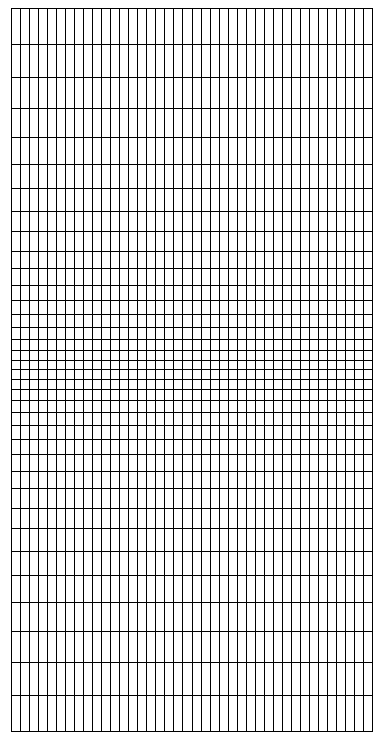3. Modeling A#
3.1. Characteristics of modeling#
The fast marching method UPWIND is used by PROPA_FISS to solve the crack propagation equations.
No auxiliary grids are used. This is possible because the mesh of the structure is very regular.
3.2. Characteristics of the mesh#
The structure is modelled by a mesh composed of 1440 elements QUAD4 (see).

Figure 1.2-a : structure mesh
The mesh is very coarse to reduce the calculation time. It is more refined in the crack propagation zone. In this area, the dimension of the elements is \(25\mathrm{\times }25\mathit{mm}\). The largest element used has a dimension equal to \(25\mathrm{\times }100\mathit{mm}\).
3.3. Tested sizes and results#
The values of \({K}_{I}\) and \({K}_{\mathit{II}}\) are tested for both cracks after each propagation. To check if these values are correct, a relative tolerance equal to \(\text{5\%}\) is used for the values of \({K}_{I}\). On the other hand, to check if the value of \({K}_{\mathit{II}}\) is zero, we use an absolute tolerance (threshold value) linked to the value of \({K}_{I}\): it is considered that \({K}_{\mathit{II}}\) is zero if its value is less than \(\text{1\%}\) of the value of \({K}_{I}\). Indeed, in this case we can overlook the value of \({K}_{\mathit{II}}\).
Propagation |
Crack |
\({K}_{I}\) reference [\(\mathit{Pa}\sqrt{\mathit{mm}}\)] |
Tolerance |
1 |
left |
3.7992E+07 |
< 5% |
righthand |
3.7992E+07 |
< 5% |
|
2 |
left |
4.1791E+07 |
< 5% |
righthand |
4.1791E+07 |
< 5% |
|
3 |
left |
4.6316E+07 |
< 5% |
righthand |
4.6316E+07 |
< 5% |
Propagation |
Crack |
\({K}_{\mathit{II}}\) reference [\(\mathit{Pa}\sqrt{\mathit{mm}}\)] |
Tolerance [\(\mathit{Pa}\sqrt{\mathit{mm}}\)] |
1 |
left |
0 |
< \({K}_{I\mathit{Aster}}/100\) |
righthand |
0 |
< \({K}_{I\mathit{Aster}}/100\) |
|
2 |
left |
0 |
< \({K}_{I\mathit{Aster}}/100\) |
righthand |
0 |
< \({K}_{I\mathit{Aster}}/100\) |
|
3 |
left |
0 |
< \({K}_{I\mathit{Aster}}/100\) |
righthand |
0 |
< \({K}_{I\mathit{Aster}}/100\) |
3.4. notes#
All values tested are within the tolerances used. This means that method UPWIND correctly calculates both the position of the two cracks and the level sets.
The error obtained on the values of \({K}_{I}\) is almost zero and the values of \({K}_{\mathit{II}}\) are always in the order of \(\text{0.01\%}\) values of \({K}_{I}\). The results obtained are therefore very satisfactory.